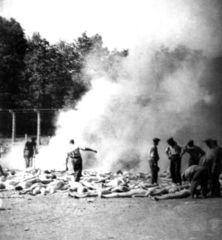Saul, a gaunt-faced and hollow-eyed man, stares out at you from the screen, seeming utterly removed, detached, dead—just like the lifeless bodies he drags from the gas chambers to the crematoria. László Nemes‘ Son of Saul or Saul Fia, in Hungarian, presents a glimpse into the horrid lives of the Sonderkommandos, the Jews of the Holocaust forced to dispose of the victims’ bodies or Stücken, meaning pieces. The film relays the story of Saul as he attempts to honor the body of a dead boy by giving him a proper burial, rather than bringing upon him the typical fate of a gassed inmate, which calls for incineration in a crematorium.
It’s not the action in this Holocaust film that draws the viewer in, although there certainly is an action-packed sequence that has you on the edge of your seat at the end of the film. It is the terrified awe and morbid curiosity that makes you want to look away, yet simultaneously stare at the small hints and flashes of the macabre cinematography. Through its cinematography, Son of Saul drives home the question that most Holocaust films address: what is it to be human? Watching Saul struggle to provide a proper burial for a dead boy in the face of those who hinder him and tell him he ought to focus on saving his own life, the viewer is confronted with his or her own humanity. One is left to question whether or not Saul is right in attempting to bury the boy, and whether he should save or risk his own neck in order to do what he believes is right.
The audience becomes very familiar with the face of Géza Röhrig, who brings the character of Saul to life. Almost the entire film consists of close-up shots of Saul’s face. As he drags the bloody and naked bodies of his Jewish brethren or leads unsuspecting victims to their deaths and into the gas chambers, the camera centers on Saul’s face while the background remains hazy and indistinct. The camera does not just remove the audience from the brunt of the death camp’s gruesomeness, but it also demonstrates that Saul’s removal from the horrific occurrences around him allows him to survive in the mad world he has been thrust into. By making the implicit statement about the Sonderkommandos — that they remained remote and aloof from the rest of the Jews in order to boost their chances of survival— László Nemes presents the issue that many deliberate over: can the Sonderkommandos be held responsible for the crimes they committed under coercion and in fear for their lives?
Although Saul is an apathetic figure in the beginning of the film, his character takes on life with grim determination as he desperately searches for a Rabbi to bury the boy who, after surviving the gas chamber, has the life choked out of him by the death camp’s doctors. The mission to bury a murdered child, no matter the cost, brings Saul to life.
It is no wonder that Son of Saul has received critical acclaim, various awards-including a Golden Globe-and positive feedback from audiences. As a cinematographic genius who centers the film on the philosophical thought of what it is to be human, Nemes presents a story driven by the desperate determination of a man, compelled by his moral imperative to maintain his humanity in spite of certain death.

